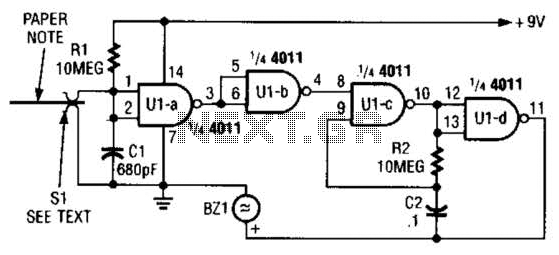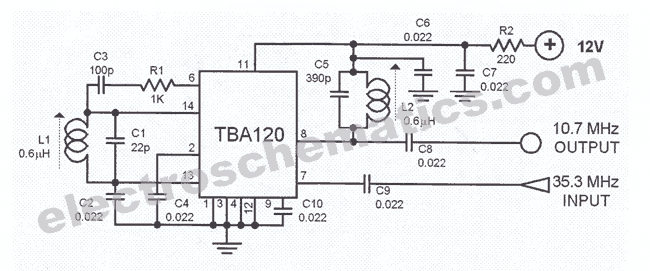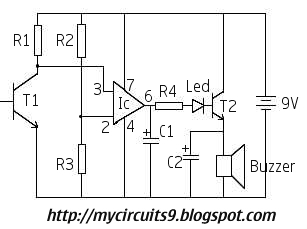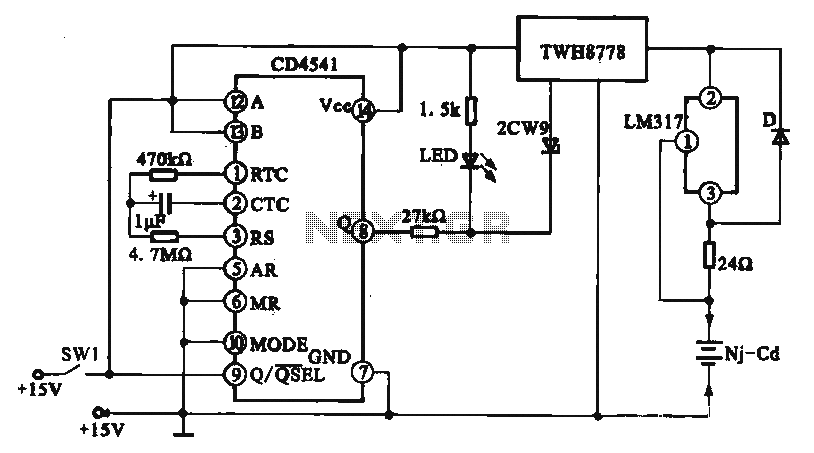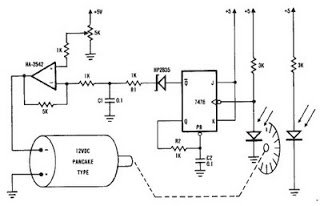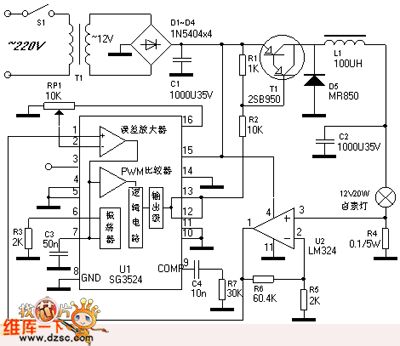
Extended delta decompression starter control circuit
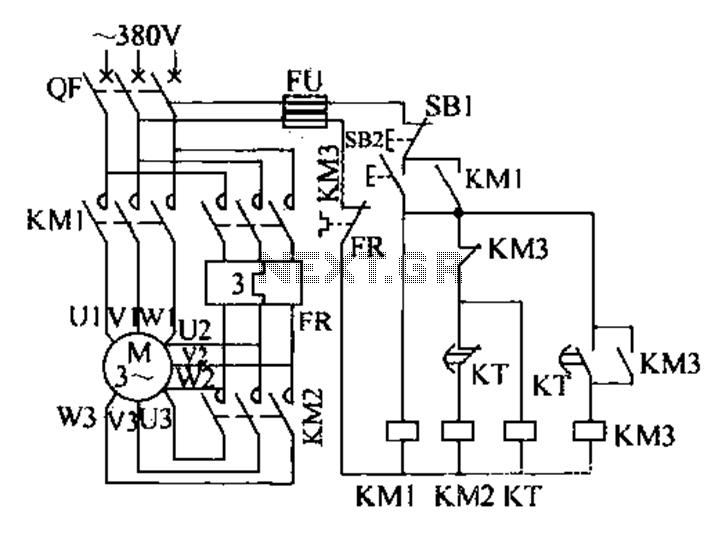
The extended delta decompression starter is designed to manage the operation of a three-phase motor during startup. It involves the initial connection of the motor's three-phase winding set to facilitate a reduced voltage startup, which is achieved through a coupling mechanism linked to an additional set of contacts. The extended delta windings enable the motor starter to transition the three-phase stator windings into a coupled operation. The control circuit for the extended delta decompression starter is illustrated in a referenced figure. Upon startup, pressing the start button (SB2) energizes the KM1 contactor, which then locks in place. This allows the three-phase power supply to connect through the KM1 main contact to the motor's outlet terminals (U1, V1, W1). Concurrently, the KM2 contactor is energized, closing its main contacts and linking the additional terminals (U2, V2, W2, U3, V3, W3) to the motor for a reduced voltage start. After a predetermined delay, the KT coil is activated, causing the KT contacts to open and de-energize the KM2 contactor, disconnecting the reduced voltage connections. The KT normally open contact then closes, energizing the KM3 contactor, which reconnects the stator windings for full voltage operation of the motor.
The extended delta decompression starter is an essential component in the control of three-phase induction motors, particularly in applications where high starting torque and reduced mechanical stress are necessary. The circuit employs a combination of contactors and relays to facilitate a smooth transition from a reduced voltage startup to full operational voltage, thereby minimizing inrush currents and preventing damage to the motor and connected equipment.
The operation begins with the pressing of the start button (SB2), which activates the KM1 contactor. This contactor serves as the primary control element, establishing a connection between the power supply and the motor. The self-locking feature of KM1 ensures that once energized, the contactor remains engaged, providing a continuous power supply to the motor.
Simultaneously, the KM2 contactor is also activated, allowing the motor to operate at a lower voltage by connecting the additional winding terminals (U2, V2, W2, U3, V3, W3). This configuration reduces the voltage applied to the motor, which is critical during the startup phase to limit the mechanical and electrical stress on the system.
The delay period, controlled by the KT coil, is a crucial aspect of this circuit. It allows the motor to reach a stable operating condition at the reduced voltage before transitioning to full voltage. Once the delay expires, the KT contacts open, de-energizing the KM2 contactor and removing the reduced voltage connections. The closing of the KT normally open contact activates the KM3 contactor, which then reconnects the motor stator windings for full voltage operation.
This method of starting a three-phase motor not only enhances the reliability and longevity of the motor but also improves energy efficiency by reducing the initial current draw. The extended delta decompression starter is particularly beneficial in applications where the motor is subject to frequent starts and stops, as it mitigates the risk of overheating and mechanical failure.Extended delta decompression starter, that is, when the motor starts its three -phase winding set to take part, eatY coupling, connected to another part of links, the entire ex tended delta windings are to be completed motor starter, three-phase stator windings into coupling operation. Extended delta decompression starter control circuit shown in Figure 4u 13. Start-up, press the start button SB2, KM1 contactor is energized and self-locking, three-phase power supply via KM1 main contact is connected to the outlet side of the motor 3 Ul, Vl, Wl.
Meanwhile contactor KM2 was electric pull, KM2 main contact is closed, respectively, U2, V3, V2, W3, W2, U3 connected Yanbian j angle, electric pressure machine start. At the same time, KT coil is energized, after a delay period of time, often wide KT j contacts disconnect power contactor KM2 release, U2, V3, V2, w3, W2, U3 uncoupled; KT normally open contact closure, KM3 was electric pull.
Respectively Ul, w2, f, U2, Wl, V2 reconnect the stator winding connected into coupling into the motor full voltage operation.
The extended delta decompression starter is an essential component in the control of three-phase induction motors, particularly in applications where high starting torque and reduced mechanical stress are necessary. The circuit employs a combination of contactors and relays to facilitate a smooth transition from a reduced voltage startup to full operational voltage, thereby minimizing inrush currents and preventing damage to the motor and connected equipment.
The operation begins with the pressing of the start button (SB2), which activates the KM1 contactor. This contactor serves as the primary control element, establishing a connection between the power supply and the motor. The self-locking feature of KM1 ensures that once energized, the contactor remains engaged, providing a continuous power supply to the motor.
Simultaneously, the KM2 contactor is also activated, allowing the motor to operate at a lower voltage by connecting the additional winding terminals (U2, V2, W2, U3, V3, W3). This configuration reduces the voltage applied to the motor, which is critical during the startup phase to limit the mechanical and electrical stress on the system.
The delay period, controlled by the KT coil, is a crucial aspect of this circuit. It allows the motor to reach a stable operating condition at the reduced voltage before transitioning to full voltage. Once the delay expires, the KT contacts open, de-energizing the KM2 contactor and removing the reduced voltage connections. The closing of the KT normally open contact activates the KM3 contactor, which then reconnects the motor stator windings for full voltage operation.
This method of starting a three-phase motor not only enhances the reliability and longevity of the motor but also improves energy efficiency by reducing the initial current draw. The extended delta decompression starter is particularly beneficial in applications where the motor is subject to frequent starts and stops, as it mitigates the risk of overheating and mechanical failure.Extended delta decompression starter, that is, when the motor starts its three -phase winding set to take part, eatY coupling, connected to another part of links, the entire ex tended delta windings are to be completed motor starter, three-phase stator windings into coupling operation. Extended delta decompression starter control circuit shown in Figure 4u 13. Start-up, press the start button SB2, KM1 contactor is energized and self-locking, three-phase power supply via KM1 main contact is connected to the outlet side of the motor 3 Ul, Vl, Wl.
Meanwhile contactor KM2 was electric pull, KM2 main contact is closed, respectively, U2, V3, V2, W3, W2, U3 connected Yanbian j angle, electric pressure machine start. At the same time, KT coil is energized, after a delay period of time, often wide KT j contacts disconnect power contactor KM2 release, U2, V3, V2, w3, W2, U3 uncoupled; KT normally open contact closure, KM3 was electric pull.
Respectively Ul, w2, f, U2, Wl, V2 reconnect the stator winding connected into coupling into the motor full voltage operation.
Warning: include(partials/cookie-banner.php): Failed to open stream: Permission denied in /var/www/html/nextgr/view-circuit.php on line 713
Warning: include(): Failed opening 'partials/cookie-banner.php' for inclusion (include_path='.:/usr/share/php') in /var/www/html/nextgr/view-circuit.php on line 713
